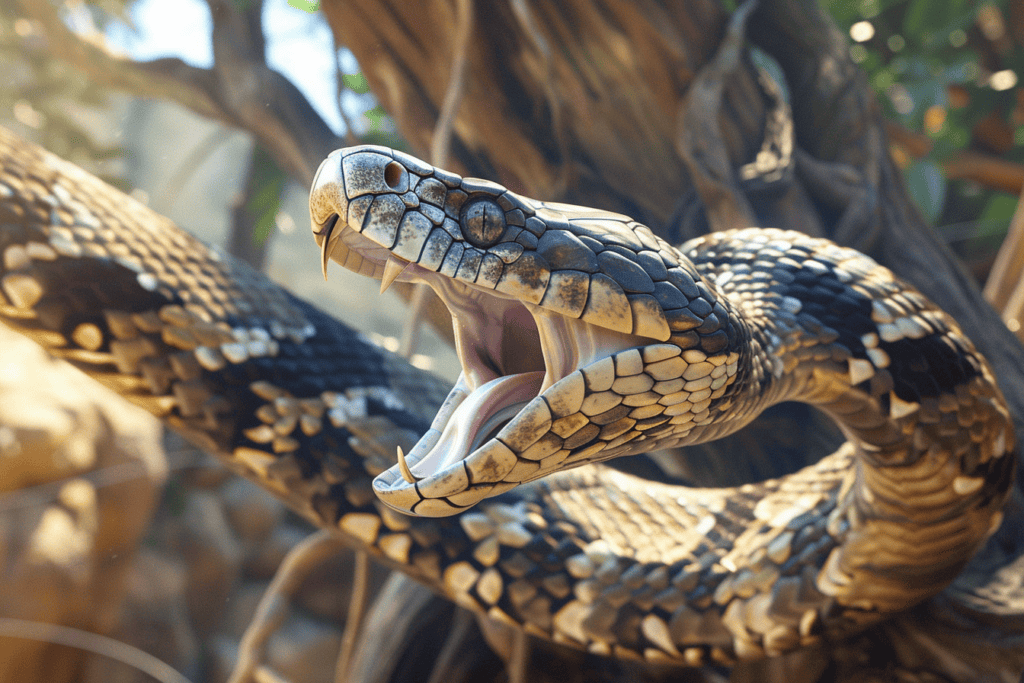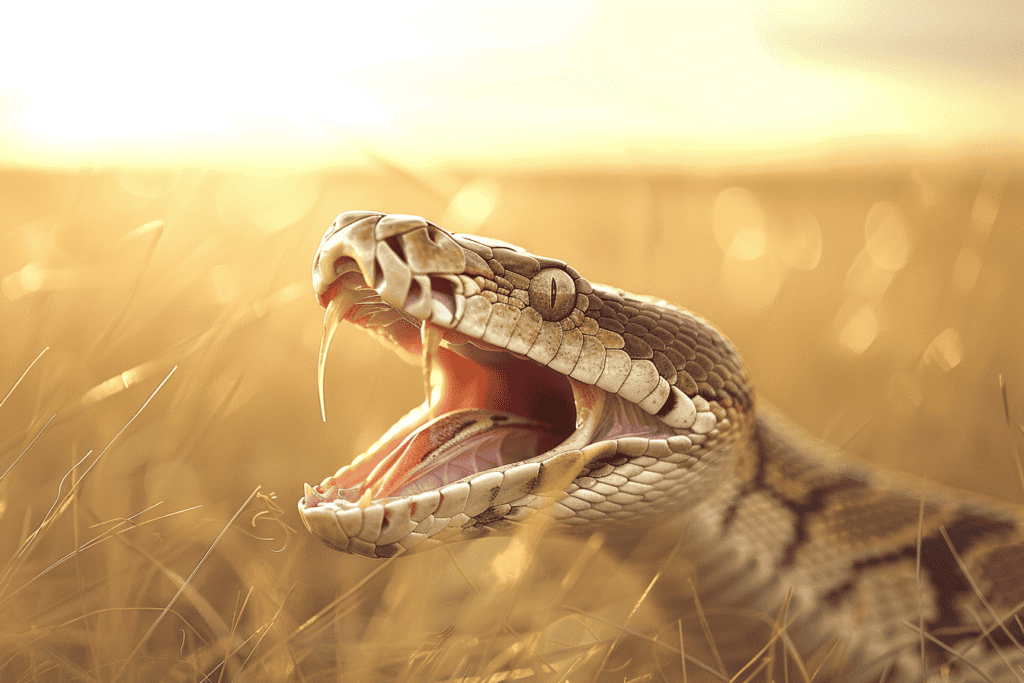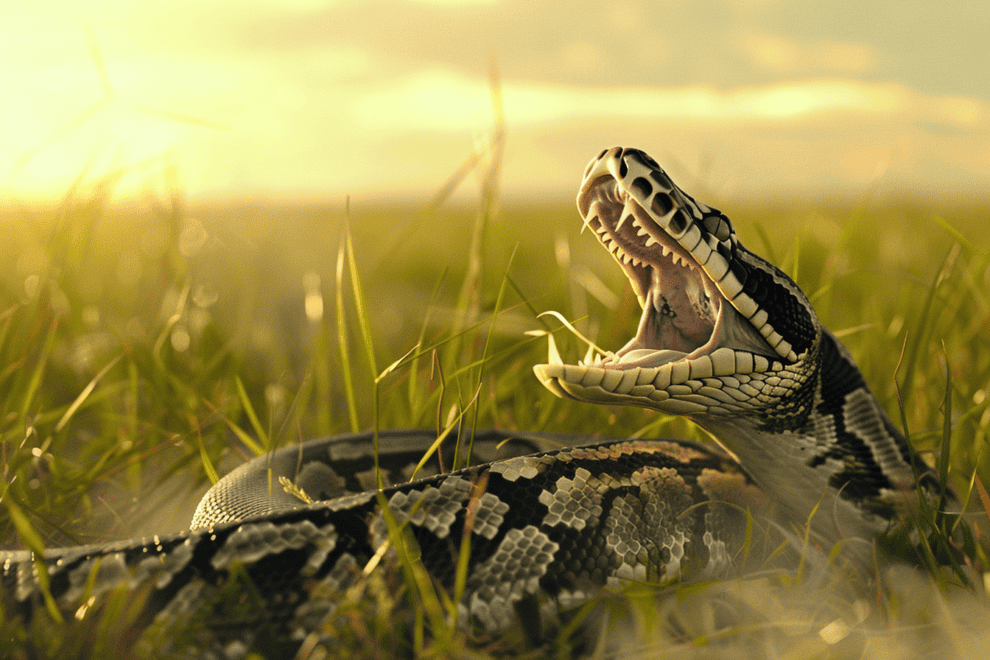Snakes are incredible creatures with unique adaptations that allow them to survive in various environments.
One of their most impressive adaptations is their ability to swallow prey that is much larger than their head.
How do they do it? The answer lies in their giant jaws and flexible ligaments.

Giant jaws are a defining characteristic of snakes, which sets them apart from other reptiles. Unlike other animals, snakes have highly mobile jaws that are not fused together, allowing them to open their mouths wide enough to swallow prey much larger than their head.
In addition to giant jaws, snakes have flexible ligaments and skin that can expand, allowing them to accommodate the size of their prey.
The ability of snakes to swallow large prey is fascinating and has been the subject of many studies.
Scientists have discovered that snakes use a combination of jaw pressure, constriction, and venom to subdue their prey.
The muscles in their esophagus contract to push the food down towards the stomach, while the snake’s spine moves behind the food, causing its ribs to push in on the food, further facilitating the swallowing process.
The Anatomy of Snake Jaws
A snake’s jaw is made up of several bones, including the mandibles and the quadrate bone.
Unlike humans, whose jaws are fused together, a snake’s jaws are connected by an elastic ligament that allows them to spread apart and move independently.
This flexibility is known as cranial kinesis and is what enables snakes to swallow prey much larger than their own heads.
How Snakes Dislocate and Realign Their Jaws
When a snake comes across a large meal, it uses its powerful muscles to grip and constrict the prey. Then, it opens its mouth as wide as it can, using its lower jaw as a lever to push the prey into its mouth.
As the prey enters the snake’s mouth, the jaws dislocate from the skull, allowing the snake to swallow the prey whole.
Once the prey is inside the snake’s mouth, the jaws realign themselves back into place. This process is made possible by the snake’s elastic ligament and specialized muscles that work together to move the bones back into position.
This realignment process can take anywhere from a few minutes to several hours, depending on the size of the meal.
The Process of Swallowing Prey Whole

The process of swallowing prey whole is not without risks. Snakes can only swallow prey items that are smaller than the widest part of their body.
If the prey item is too large, the snake may not be able to swallow it, or worse, it may become stuck in the snake’s digestive tract, causing serious health problems.
To digest their super-sized meals, snakes have evolved a range of anatomical adaptations. For starters, their jaws are not fused together like ours.
Instead, they are connected by elastic tendons that allow the jaws to stretch wide, enabling the snake to swallow prey items much larger than its head.
Once the prey is swallowed, the snake’s digestive system goes to work. The snake’s stomach produces powerful digestive enzymes that break down the prey’s fur, bones, and other tough materials.
The snake’s gastrointestinal tract is also adapted to handle large meals, with a highly expandable stomach that can stretch to accommodate prey items several times larger than the snake’s head.
In addition to these anatomical adaptations, snakes have also developed behavioral adaptations to aid in digestion.
Some species of snakes, such as pythons, can raise their body temperature by several degrees to speed up the digestion process.
Other species of snakes, such as boa constrictors, use constriction to squeeze the prey item, breaking down its bones and making it easier to digest.
Challenges with Unusually Large or Tough Prey

Snakes are known for their ability to swallow prey whole, but sometimes they bite off more than they can chew. When snakes encounter prey that is too large or tough to swallow, they face a number of challenges.
One of the biggest challenges is getting the prey into their mouths. Snakes have flexible jaws that allow them to open their mouths very wide, but there are limits to how wide they can open. If the prey is too large to fit in their mouths, they may have to use other strategies to subdue it.
Another challenge is actually swallowing the prey. Snakes have backward-pointing teeth that help them grip and swallow their prey, but if the prey is too large, they may have difficulty getting it down their throats. In some cases, snakes may have to regurgitate the prey and try again.
Incredible Feats: From Alligators to Antelopes
Despite these challenges, some snakes have been known to take down super-sized meals. For example, green anacondas have been known to eat capybaras, while reticulated pythons have been known to eat pigs and even cows.
In some cases, snakes have been known to take on prey that is much larger than themselves. For example, a 14-year-old boy in Indonesia was swallowed whole by a reticulated python in 2017. In another case, a Burmese jewelry salesman was swallowed by a python in 2002.
Snakes are not the only predators that can take down large prey. Alligators and crocodiles are also known for their ability to take down large animals. In fact, some species of crocodile have been known to eat antelopes.
Frequently Asked Questions

How do snakes manage to swallow prey larger than their own head?
Snakes have an incredible ability to swallow prey that is several times larger than their own head. They achieve this by having a highly flexible jaw structure that allows them to open their mouths wider than any other animal on earth. In fact, some species of snakes can open their jaws up to 150 degrees! This enables them to wrap their jaws around their prey and slowly work it down their throat.
What special adaptations do snake jaws have for consuming big meals?
The jaw structure of snakes is unique and is designed specifically for consuming large meals. Rather than having a rigid jaw structure like humans, snakes have a highly flexible jaw that is connected by elastic tendons. This allows them to open their mouth wide enough to swallow prey that is several times larger than their own head. Additionally, snake jaws are not fused at the chin, allowing them to move independently of each other. This is a crucial adaptation that enables them to manipulate and swallow their prey.
Can you explain the anatomy that allows a snake to eat something several times its size?
Snakes have a highly flexible jaw structure that is made up of many small bones and elastic tendons. This unique anatomy allows them to open their mouth wider than any other animal on earth.
Additionally, snake jaws are not fused at the chin, allowing them to move independently of each other. This enables them to manipulate and swallow prey that is several times larger than their own head.
Once the prey is in their mouth, they use their powerful muscles to slowly work it down their throat.
What’s the process snakes go through when they’re devouring large prey?
When a snake catches its prey, it will first subdue it using constriction or venom. Once the prey is immobilized, the snake will begin to swallow it whole.
The snake will use its flexible jaw to open its mouth wide enough to wrap its jaws around the prey. It will then slowly work the prey down its throat, using its powerful muscles to move it along.
This process can take several hours or even days, depending on the size of the prey.
How does the flexibility of a snake’s jaw contribute to its hunting strategy?
The flexibility of a snake’s jaw is a crucial adaptation that enables it to hunt and consume prey that is several times larger than its own head.
By having a highly flexible jaw structure, snakes are able to open their mouth wider than any other animal on earth. This enables them to wrap their jaws around their prey and slowly work it down their throat.
Additionally, the independent movement of their jaws allows them to manipulate and swallow their prey more easily.
Are there any limits to the size of prey a snake can consume, and how do their jaws cope with this?
While snakes are able to consume prey that is several times larger than their own head, there are limits to what they can ingest.
If a snake attempts to swallow prey that is too large, it can result in the dislocation of their jaw. However, their highly flexible jaw structure allows them to consume prey that is much larger than their own head, as long as it is within their limits.
Additionally, some species of snakes have evolved to consume larger prey by developing a more robust jaw structure.









